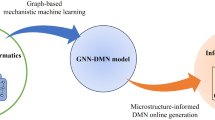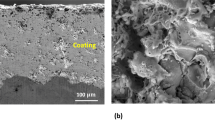Neural networks are one of the newest tools for computation. They provide unique opportunities for understanding and studying nonlinear problems, which makes such networks well-suited for use in different fields of engineering and technology. Only a few studies employing this new tool have been conducted in the field of ceramics. In the study discussed in this article, a three-layer neural network was used to construct a model that can predict the amounts of synthetic resin and graphite which graphite-bearing magnesia-carbon refractories should contain in order to maximize their compressive strength and minimize their open porosity. The neural network that was created can successfully predict results, and it predicted that compressive strength will be maximal and porosity will be minimal when graphite content is within the range 10 – 17.5% and the content of synthetic resin is 3%.





Similar content being viewed by others
References
Neural Networks, Ph. Picton, translation by M. Ghazanfari. IUST publication, 2004.
D. Li, L. Sun, G. Gao, et al., “Artificial neural network approach for modeling of conversion rate of refractory gold concentrate oxidation by nitric acid,” IEEE, 978-1-4244-4738, 2009.
Calculator Intelligence, M. B. Menhaj. Professor Hesabi publication (2000).
C. Z. Huang, L. Zhang, L. He, et al., “A study on the prediction of the mechanical properties of a ceramic tool based on an artificial neural network,” Journal of Material Processing Technology, 129, 399–402 (2002)
M. O. Guler and R. Artir, “Modular neural network modeling of compressive strength of high-alumina bricks by using tangent function,” in: Materials and Design (2005).
D. Guoa, Y. Wanga, J. Xiab, et al., “Investigation of BaTiO3 formulation: an artificial neural network (ANN) method,” Journal of the European Ceramic Society, 22, 1867–1872 (2002).
H. S. Rao, V. G. Ghorpade, A. Mukherjee, “A genetic algorithm based back propagation network for simulation of stress–strain response of ceramic-matrix-composites,” Computers and Structures, 84, 330–339 (2006).
V. N. Gaitonde, S. R. Karnik, L. Figueira, et al., “Performance comparison of conventional and wiper ceramic inserts in hard turning through artificial neural network modeling,” International Journal of Advanced Manufacture Technology, 52, 101–114 (2011).
J. Zhang, M. Yi, Ch. Xu, and Z. Jiang, “Prediction of the mechanical properties of ceramic die material with artificial neural network and genetic algorithm,” IEEE, 978-1-4244-4738 (2009).
European Refractories Producers’ Federation, “Refractory Ceramics and Industrial Minerals are Critical for European Industry,” May 2009, www.pre.eu.
Z. A. Nemati and P. Moetakef, “Investigation of graphite oxidation kinetics in MgO–C composite via artificial neural network approach,” Computational Materials Science, 39, 723–728 (2007).
A. Bhatia, PhD Course Content “Overview of Refractory Materials”, 18 January 2010, http://www.pdhonline.org.
A. G. De la Torre, F. J. Valle, and A. H. De Aza, “Direct mineralogical composition of a MgO–C refractory material obtained by Rietveld methodology”, Journal of the European Ceramic Society, 26, 2587–2592 (2006).
A. Phillipps, D. Simkin, M. Witt, et al., “Thermal shock resistance of alumina-graphite refractories for the continuous casting of steel,” Proceedings of UNZTECR 1995, Kyoto, Japan (1995) pp. 63–72.
O. Krause, G. Mortl, R. Weidemüller, et al., “Properties and behavior of iso-statically pressed refractories for the continuous casting process on alumina-graphite and MgO-graphite basis,” Radex-Rundschau, 61(3), 1–623 (1985).
D. A. Bell, “What can tests tell us about the service performance of steelplant refractories,” Proceedings of the St. Louis Section of the American Ceramic Society, St. Louis, MO, 1992, March 27.
L. Li, Tang Guang-sheng, He Zhi-yong, et al., “Influences of black carbon addition on mechanical performance of low-carbon MgO–C composite,” Journal of Iron and Steel Research International, 17(12), 75–78 (2010).
A. A. Wereszczak, J. D. Smith, and R. E. Moore, “Probabilistic life design of refractories for steel casting,” Unitecr (1998).
M. Bavand-Vandchali, H. Sarpoolaky, F. Golestani-Fard, et al., “Atmosphere and carbon effects on microstructure and phase analysis of in situ spinel formation in MgO–C refractories matrix,” Ceramics International, 35, 861–868 (2009).
Author information
Authors and Affiliations
Additional information
Translated from Novye Ogneupory, No. 6, pp. 41 – 46, June, 2012.
Rights and permissions
About this article
Cite this article
Mazloom, M., Sarpoolaky, H. & Savabieh, H.R. Use of neural networks to optimize graphite content in magnesia-graphite refractories. Refract Ind Ceram 53, 193–198 (2012). https://doi.org/10.1007/s11148-012-9491-5
Received:
Published:
Issue Date:
DOI: https://doi.org/10.1007/s11148-012-9491-5




